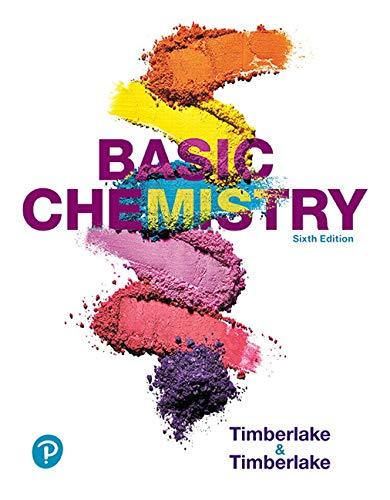
Concept explainers
(a)
Interpretation:
Interpret Lewis structure of HF
Concept Introduction:
Lewis dot structure is the representation of the atom bonded to each other to form a molecule or compound.
The bond formation between the atoms takes place due to the sharing of valence electrons between them while the remaining outer electron denoted as lone pair of electrons.
(b)
Interpretation:
Interpret Lewis structure of SF2
Concept Introduction:
Lewis dot structure is the representation of the atom bonded to each other to form a molecule or compound.
The bond formation between the atoms takes place due to the sharing of valence electrons between them while the remaining outer electron denoted as lone pair of electrons.
(c)
Interpretation:
Interpret lewis structure of NBr3
Concept Introduction:
Lewis dot structure is the representation of the atom bonded to each other to form a molecule or compound.
The bond formation between the atoms takes place due to the sharing of valence electrons between them while the remaining outer electron denoted as lone pair of electrons.
(d)
Interpretation:
Interpret lewis structure of BH4-
Concept Introduction:
Lewis dot structure is the representation of the atom bonded to each other to form a molecule or compound.
The bond formation between the atoms takes place due to the sharing of valence electrons between them while the remaining outer electron denoted as lone pair of electrons.
(e)
Interpretation:
Interpret lewis structure of CH3OH
Concept Introduction:
Lewis dot structure is the representation of the atom bonded to each other to form a molecule or compound.
The bond formation between the atoms takes place due to the sharing of valence electrons between them while the remaining outer electron denoted as lone pair of electrons.
(f)
Interpretation:
Interpret lewis structure of N2H4
Concept Introduction:
Lewis dot structure is the representation of the atom bonded to each other to form a molecule or compound.
The bond formation between the atoms takes place due to the sharing of valence electrons between them while the remaining outer electron denoted as lone pair of electrons.
Want to see the full answer?
Check out a sample textbook solution
Chapter 10 Solutions
Basic Chemistry Plus Mastering Chemistry With Pearson Etext -- Access Card Package (6th Edition)
- If we react tetraethoxypropane with hydrazine, what is the product obtained (explain its formula). State the reason why the corresponding dialdehyde is not used.arrow_forwarddrawing, no aiarrow_forwardIf CH3COCH2CH(OCH3)2 (4,4-dimethoxy-2-butanone) and hydrazine react, two isomeric products are formed. State their structure and which will be the majority.arrow_forward
- + Reset Provide the correct IUPAC name for the compound shown here. 4-methylhept-2-ene (Z)- (E)- 1-6-5-2-3-4- cyclo iso tert- sec- di tri hept hex oct meth eth pent ane yne ene ylarrow_forward+ Provide the correct IUPAC name for the compound shown here. Reset H3C H H C CH3 CH-CH3 1-3-methylpent ene trans- cis- 5-6-3-1-2-4- tert- tri sec- di cyclo iso but pent hex meth prop eth yl ane ene yne ☑arrow_forwarddrawing, no aiarrow_forward
- drawing, no aiarrow_forwardDraw the major organic product when each of the bellow reagents is added to 3,3-dimethylbutere. ✓ 3rd attempt Part 1 (0.3 point) H.C CH CH + 1. BHG THF 210 NaOH NJ 10000 Part 2 (0.3 point) HC- CH HC 2741 OH a Search 1. He|DA HO 2. NIBH さ 士 Ju See Periodic Table See Hint j = uz C H F F boxarrow_forwardSynthesis of 2-metilbenzimidazol from 1,2-diaminobenceno y propanona.arrow_forward
- Chemistry: Matter and ChangeChemistryISBN:9780078746376Author:Dinah Zike, Laurel Dingrando, Nicholas Hainen, Cheryl WistromPublisher:Glencoe/McGraw-Hill School Pub Co
 Organic Chemistry: A Guided InquiryChemistryISBN:9780618974122Author:Andrei StraumanisPublisher:Cengage Learning
Organic Chemistry: A Guided InquiryChemistryISBN:9780618974122Author:Andrei StraumanisPublisher:Cengage Learning Introductory Chemistry: An Active Learning Approa...ChemistryISBN:9781305079250Author:Mark S. Cracolice, Ed PetersPublisher:Cengage Learning
Introductory Chemistry: An Active Learning Approa...ChemistryISBN:9781305079250Author:Mark S. Cracolice, Ed PetersPublisher:Cengage Learning  World of Chemistry, 3rd editionChemistryISBN:9781133109655Author:Steven S. Zumdahl, Susan L. Zumdahl, Donald J. DeCostePublisher:Brooks / Cole / Cengage Learning
World of Chemistry, 3rd editionChemistryISBN:9781133109655Author:Steven S. Zumdahl, Susan L. Zumdahl, Donald J. DeCostePublisher:Brooks / Cole / Cengage Learning Chemistry & Chemical ReactivityChemistryISBN:9781337399074Author:John C. Kotz, Paul M. Treichel, John Townsend, David TreichelPublisher:Cengage Learning
Chemistry & Chemical ReactivityChemistryISBN:9781337399074Author:John C. Kotz, Paul M. Treichel, John Townsend, David TreichelPublisher:Cengage Learning Introductory Chemistry: A FoundationChemistryISBN:9781337399425Author:Steven S. Zumdahl, Donald J. DeCostePublisher:Cengage Learning
Introductory Chemistry: A FoundationChemistryISBN:9781337399425Author:Steven S. Zumdahl, Donald J. DeCostePublisher:Cengage Learning





